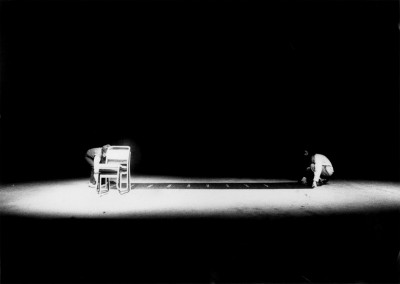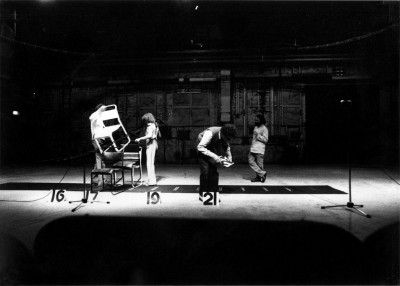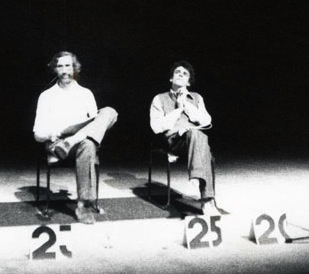THE GOVERNMENT OF THE FIRST AND THIRTEENTH CHAIR
10 March 2012 2 - 7pm at Wysing Arts Centre, Cambridgeshire
A special performance John Latham's work, The Government of the First and Thirteenth Chair with a script re-worked by Mark Aerial Waller with students from NUCA
The event is part of a day of performances and live works that look at ideas around space and time. An archival exhibition of The Government of the First and Thirteenth Chair will open at Flat Time House Friday 30 March 2012.
The performance of the late John Latham's work at Wysing is the first of a series of new re-workings of the artist's play The Government of the First and Thirteenth Chair, for camera, for live audience and for publication over the next 18 months. In this collaboration between Wysing, Flat Time House and Norwich University College of the Arts (NUCA), artist Mark Aerial Waller has reworked Latham's original script and stage directions with students from NUCA to develop a new version of the play, which expresses Latham's theories of space and time.
The play was first performed in 1978 as part of a week of Artists Placement Group (APG) events held at Riverside Studios, London. Latham used commonly found stackable chairs and laid out a numbered grid along the set floor. Numbers between 1 and 36 were displayed, with several chairs facing the audience. These 36 positions or 'bands' were first seen in Latham's Time Base Roller works which are an attempt by the artist to physically embody time through art. Within Latham's theories of temporality and evolution a 'least event' or the smallest event possible, is the represented at Band 1 and the universe as event at Band 36. Between these two extremes, the spectrum allows for the understanding of all cosmological, geological or spiritual phenomena, all physical, emotional or psychological states within the same system.
The Government of the First and Thirteenth Chair was performed again in 1991 at the Oxford University Debating Chamber involving students from the Ruskin School of Art. In the play, six performers work from a basic script and framework from by John Latham and improvise much of the dialogue. The play involves two acts with the first act representative of the creation of something from nothing - or a least event - using two chairs representing the traditions of science and art. Two performers enact a conflict between the two chairs/traditions and the act closes with a resolution. Act Two involves all the performers along the horizontal time base spectrum, each enacting the various stages of evolution and development from the most simplistic organism through to the most evolved intuitive being. The performers move up and down the time base, a performative allegory of Latham's Event Based theories.
"In all probability viewers did not distil a single meaning from Government because it was designed to generate associations . Like the evolution of life itself it became more complex over time and reflected the influence of chance. Latham once compared it to the Rorschach ink blot which encourages viewers to project their own meanings onto it."
(John A. Walker, 'John Latham, The Incidental Person', Middlesex University Press, 1994)



About the 10 March at Wysing Arts Centre
The performance is part of a day of live works and screenings around Wysing's current exhibition The Starry Rubric Set, which uses classical astrology as a device to present work made by artists who were in residence at the arts centre during and to introduce the themes of the centre's programme for 2012.
Wysing Arts Centre shapes new ways of working in the arts and challenges artists and audiences to re-think what is possible, often in partnership with each other. In the last five years this approach has led to the creation of extraordinary projects and experiences, and has made Wysing one of Europe's leading centres for the visual arts. With a large rural site comprising 10 separate buildings including artists' studios, educational and new media facilities, a gallery and project spaces; with an ongoing and innovative artistic programme of events, exhibitions, retreats and residencies; and a unique programme for young artists, Wysing Arts Centre is delivering a rich programme that is accessible on many levels to a range of people. Art developed at Wysing is increasingly shown at significant venues around the world, and Wysing is part of national networks including Plus Tate, the Arts Council National Portfolio and Own Art.
About Mark Aerial Waller
Mark Aerial Waller is an artist who works with video, sculpture and event-based practices. His many films, installations and events condense forms and symbolic orders from multiple time zones into a skillfully articulated present tense. Mark defies conventional screening formats, integrating sculptural objects and live performances for an experience of cinema defined in spatial and situational terms. He is also the founder of The Wayward Canon, a platform for event-based interventions in cinematic practices.
The Government of the First and Thirteenth Chair
The Government of the First and Thirteenth Chair has been developed in collaboration with Elisa Kay, Hana Noorali, Claire Louise Staunton, Flat Time House and NUCA.

THE GOVERNMENT OF THE FIRST AND THIRTEENTH CHAIR
Following a performance at Wysing Arts Centre on 10 March with a reworked script, Flat Time House presents an exhibition including an installation of the original set with props, preparatory material and documentation from performances in 1978, 1991 and 2012